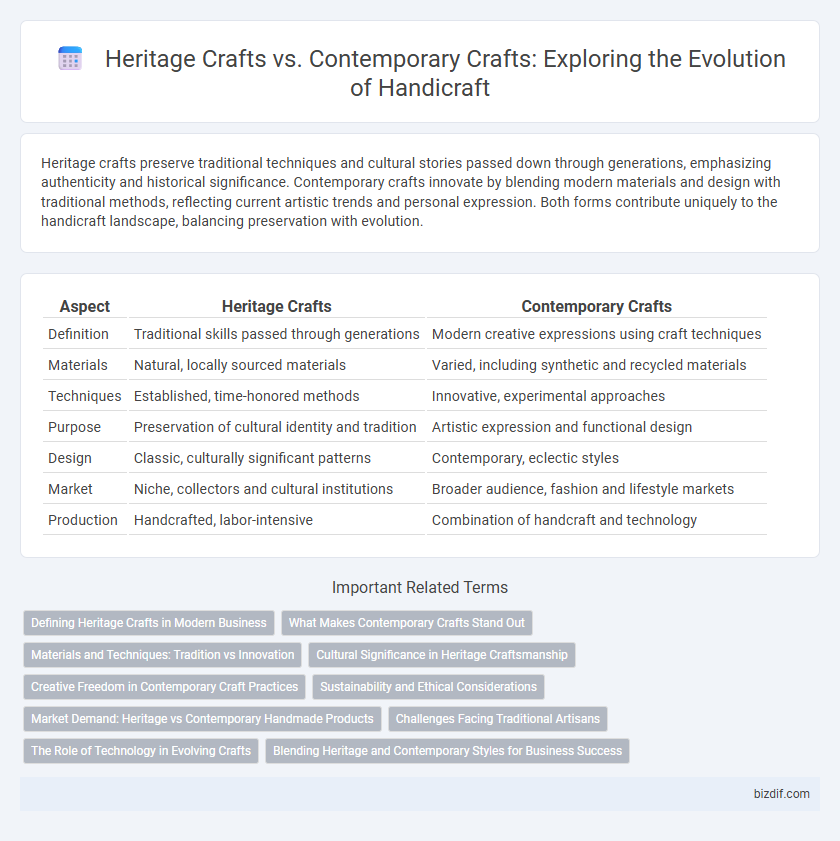Heritage crafts preserve traditional techniques and cultural stories passed down through generations, emphasizing authenticity and historical significance. Contemporary crafts innovate by blending modern materials and design with traditional methods, reflecting current artistic trends and personal expression. Both forms contribute uniquely to the handicraft landscape, balancing preservation with evolution.
Table of Comparison
| Aspect | Heritage Crafts | Contemporary Crafts |
|---|---|---|
| Definition | Traditional skills passed through generations | Modern creative expressions using craft techniques |
| Materials | Natural, locally sourced materials | Varied, including synthetic and recycled materials |
| Techniques | Established, time-honored methods | Innovative, experimental approaches |
| Purpose | Preservation of cultural identity and tradition | Artistic expression and functional design |
| Design | Classic, culturally significant patterns | Contemporary, eclectic styles |
| Market | Niche, collectors and cultural institutions | Broader audience, fashion and lifestyle markets |
| Production | Handcrafted, labor-intensive | Combination of handcraft and technology |
Defining Heritage Crafts in Modern Business
Heritage crafts in modern business preserve traditional techniques and cultural expressions passed down through generations, often emphasizing authenticity and sustainability. These crafts typically involve hand-made processes using natural materials, reflecting regional identities and historical significance. Integrating heritage crafts into contemporary markets enhances product uniqueness and supports cultural preservation while meeting growing consumer demand for ethically sourced and artisanal goods.
What Makes Contemporary Crafts Stand Out
Contemporary crafts stand out by integrating innovative materials and modern techniques while maintaining a strong connection to traditional craftsmanship. These crafts often emphasize originality, functional design, and artistic expression, appealing to a broader, more diverse audience. Unlike heritage crafts that preserve historical methods, contemporary crafts push boundaries by blending creativity with sustainability and technology.
Materials and Techniques: Tradition vs Innovation
Heritage crafts rely on time-honored materials such as natural fibers, wood, and clay, utilizing techniques passed down through generations to preserve cultural authenticity. Contemporary crafts incorporate innovative materials like recycled plastics, metals, and mixed media, blending traditional methods with modern technology for enhanced functionality and aesthetic appeal. The evolving fusion of tradition and innovation in materials and techniques reflects the dynamic nature of craft in today's artistic landscape.
Cultural Significance in Heritage Craftsmanship
Heritage crafts embody centuries-old techniques and cultural narratives passed down through generations, preserving the identity and traditions of specific communities worldwide. These crafts often utilize indigenous materials and methods that reflect the historical context and spiritual values unique to each culture. Contemporary crafts, while innovative and adaptive, often draw inspiration from heritage craftsmanship but may lack the deep-rooted cultural significance inherent in traditional artisan practices.
Creative Freedom in Contemporary Craft Practices
Contemporary craft practices prioritize creative freedom by encouraging experimentation with new materials, techniques, and artistic expressions, breaking away from the traditional rules that define heritage crafts. This shift fosters innovation and personal interpretation, enabling artisans to blend cultural influences with modern design principles. The result is a dynamic craft landscape where individuality and originality drive the evolution of craft forms.
Sustainability and Ethical Considerations
Heritage crafts emphasize sustainability through traditional, eco-friendly materials and techniques passed down generations, minimizing environmental impact and promoting cultural preservation. Contemporary crafts integrate innovative, sustainable practices by incorporating recycled materials and ethical sourcing standards to address modern ecological concerns. Both approaches prioritize ethical craftsmanship, with heritage crafts focusing on preserving artisan livelihoods and contemporary crafts emphasizing transparency and responsible production.
Market Demand: Heritage vs Contemporary Handmade Products
Heritage crafts maintain steady market demand due to their authenticity, cultural significance, and traditional techniques that appeal to collectors and heritage enthusiasts. Contemporary handmade products see increasing popularity in urban markets, driven by modern aesthetics, customization options, and eco-conscious consumers seeking unique, artisanal goods. Market trends indicate a growing blend where heritage techniques are integrated into contemporary designs, expanding appeal across diverse consumer segments.
Challenges Facing Traditional Artisans
Heritage crafts face significant challenges including a declining number of skilled artisans, limited market access, and competition from mass-produced goods that undermine the value of handcrafted pieces. Traditional artisans struggle to balance preserving authentic techniques with adapting to modern consumer preferences and digital marketing landscapes. Economic pressures and inadequate policy support further threaten the sustainability of these time-honored crafts, risking the loss of cultural heritage.
The Role of Technology in Evolving Crafts
Technology transforms heritage crafts by introducing digital tools for design precision and replication without compromising traditional techniques. Contemporary crafts heavily incorporate advanced technology such as 3D printing, laser cutting, and computer-aided design (CAD) to expand creative possibilities and production efficiency. This fusion of technology with craftsmanship fosters innovation while preserving cultural values and artisanal skills.
Blending Heritage and Contemporary Styles for Business Success
Blending heritage crafts with contemporary styles creates unique products that appeal to modern consumers while preserving traditional techniques. Artisans who integrate cultural motifs and age-old methods with innovative designs can differentiate their brands in competitive markets. This fusion not only boosts business success but also sustains cultural heritage by making it relevant to today's global audience.
Heritage crafts vs Contemporary crafts Infographic

 bizdif.com
bizdif.com